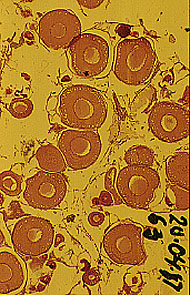 fig. ╧ 2;
fig. ╧ 2; 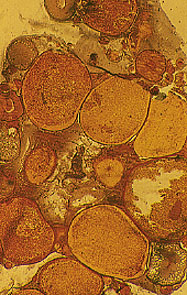 fig. ╧ 3;
fig. ╧ 3;Polycyclic spawning of
silver carp (Hypophthalmichthys molitrix Val.), bighead carp (Aristichthis nobilis Rich.)
which growig up in cages in warm water.
Essential factor which is brake of improvement of quality and quantity of larvae of fishes-filtrators, which was cultavated in саges in warm technical reservoirs, is one-time-using of the fishes with the purpose of spawning.

Fig. ╧ 1;
On such саges lines are breeding our fishes. Significant convenience is the opportunity to reach to cages directly from a coast by floating road.It is caused by high percent of destruction of the fishes which have undergone to influence of gonadotropic injections preparations. The search of an opportunity of increase of quantity of the fishes which have survived after receptions of sexual products, was the important task in all countries, where сultivated these fishes.
The search of an opportunity of increase of quantity of the fishes which have survived after receptions of their sexual products, was the important task in all countries, where this fishes are cultivate.
The reason of destruction of fishes are the traumas, hormonal status disbalance and both discrepancy of a condition of eggs in sex glands with doze of stimulating preparations.
Changing of a physiological condition of fishes results in turbidity an eyes, infringement of coordination of movements to an inflammation of integumentary tissue and at the end to destruction.
The technique, developed by author, inlive, untrauming of definition of readiness of fishes to spawning enables in field conditions with the help of the simple device precisely to define condition of eggs and to correct quantity and doze of injections (Рудь, 1989; Rud,1990). It promotes preservation of fishes, prоtect them organism against excess of a doze gormone preparation. In addition improves safety application of special heal preparations. The safety males and females enables of their repeated use with the purpose of spawning. Without it, the process of scientific selection to the most favorable attributes is impossible. Besides, has become possible to define features of development of new generation ovules at females, contained in саges in warm water.
Thus males of both species are ready to polination since April till October.
Technique of researches.
In the researches we used females of the 4-th years age (+ 3), average alive weight: Silver carp - 2260 gr. Marmour (bighead) carp - 2360 gr. The fishes were rear up in саges in volume 24 m3 at temperature of water: in the summer - 26-34; in the winter - is not lower 7oC.Results of researches.
The quantity of the dissolved oxygen near of an arrangement of cages on the average made 5.5mg/l, also was not reduced below 4.0 mg/l. Fodder maintenance - average bioweight of phytoplankton since May till October was 3.14 - 5.8 g/m3.In May 1990 was preservated females: 22 bighead carp and 12 silver carp. In July (12.07.90) from them eggs again was received. And later (27.08.90) from females bighead carp the eggs was received. Thus, in 1990 since may till august, from silver carp the posterity was received twice, and from bighead - three times.
By 10.10.90 first generation had average weight - 120 g (silver carp), 115 g (bighead carp); the second generation accordingly - 3.45 g, 2.97 g; The third generation bighead carp - 157.57 mg. The winter period in cages passed at complete absence artificial feeding.
By 08.05.91 first generation was displaced and it was not taken into account average, second generation had - 15g (silver carp), 14.3 g (bighead carp); The third generation bighead carp - 3 g. The increase of weight two generations of posterity in the winter period is caused by migration of plankton from cold sites of a reservoir to mouth of the channel with warm water, where the cages are placed.
The hystological analysis of sex glands has shown features of development and opportunity of their repeated maturing in one season.
The definition of a condition ovule before the beginning (artificial spawning) incubation eggs has the importance meaning. At this time is important not miss achievement of good ovule condition and not begin work too early.
 fig. ╧ 2;
fig. ╧ 2;  fig. ╧ 3;
fig. ╧ 3;
In figure 2 is represented ovary's site with unripe ovule of two generations.
In figure 3 is represented ovary with attributes of overmature in two eggs with thicking of membrane.
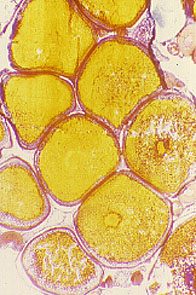 fig. ╧ 4;
fig. ╧ 4;  fig. ╧ 5;
fig. ╧ 5;
 fig. ╧ 6;
fig. ╧ 6; 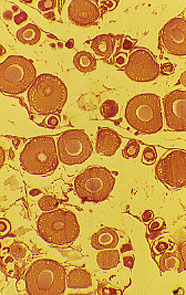 fig. ╧ 7;
fig. ╧ 7; 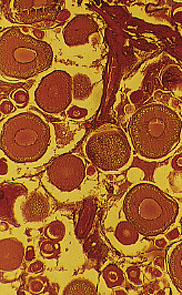 fig.╧ 8;
fig.╧ 8;
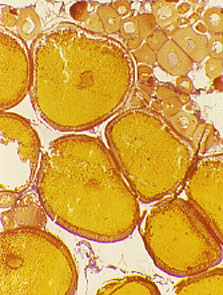 fig.╧ 9;
fig.╧ 9;  fig.╧ 10;
fig.╧ 10;
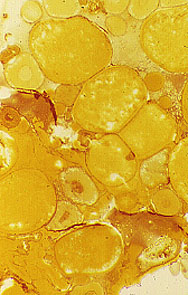
fig.╧11;
Stage of readiness on fig. ╧ 4 will be finished migration of a nucleus to an membrane of cell. The evacuation of eggs will give tendention to development of the following youngest generation, that is visible on fig. ╧ 5.
Fig. ╧ 6,7,8 demonstrate a sequence of process of maturing ovules again up to a condition of readiness Fig. ╧ 9.
If an egg will not be evacuation from ovary, there will come process degeneration Fig. ╧10,11. The purpose of the given technology, is to not admit given process.
Each ripened generation eggs should be used with the purpose of reception of posterity.
The given technology allows:
a/ to preservation alive the most valuable fishes (Hypophthalmichthys molitrix (Val.){silver carp}, Aristichthis nobilis (Rich.) {marmour carp or bighead carp}, Ctenopharyngodon idella (Val.){grass carp or white amur}, Myliopharingodon picceus {Chinese Black Carp or black amur} for use them repeatedly;
b/ to receive in one season a lot of posterity, than at traditional technology;
c/ to receive posterity in earlier terms in the following season;
d/ with the large effect to use the equipment;
e/ to receive the greater economic benefit of operation with herd;
This technology do not demand adding investments expenses, includes elements of "know how", giving raises culture and quality of manufacture, has significant quantity of additional positive consequences, which require a statement in special articles.
Literature
1. Рудь Н.П. К вопросу определения степени зрелости рыб к нересту. Тез докл. Интенсивные методы ведения рыбного х-ва в водоемах Украины, апрель 1989 г. , Херсон, Киев, 1990, с. 35-36;
2. Rud N.P. Der Einsatz eines Endoskops zur Ermittlung der Laichreife 1990 bei Fischen // Z.Binnefischerei DDR. 37 (3) 1990. Bd.37, N 3. s.105-106.
The additional data on the given material you can receive by addressing to the author < nature@nature.kiev.ua >